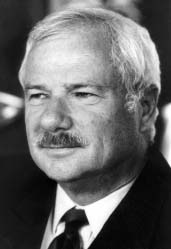Helmschrott, Robert
Biography
Born: August 23, 1938
Country: Weilheim, Bavaria, Germany
Studies: Hochschule für Musik, Munich
Teachers: Harald Genzmer, Fritz Büchtger
Website: http://www.robert-helmschrott.de/
Robert M. Helmschrott, born in Weilheim, Upper Bavaria, in 1938, completed his music studies at the Hochschule für Musik und Theater in Munich (an academy for music and theatre). There followed further studies with the Tournemire student Pierre Froidebise in Liège, Belgium, and with Goffredo Petrassi and Luigi Dallapiccola in Siena/Italy. Helmschrott received a scholarship from the Deutsche Akademie Villa Massimo in Rome (1967-69), and a scholarship from the Cité Internationale des Arts in Paris (1975), and he was “Artist-in-Residence” in the MacDowell Colony Peterborough, N.H./USA (1993). He was awarded several national and international prizes for compositions. Helmschrott has written liturgical music, choir music, chamber music and orchestral work. A major part of his work is dedicated to organ music (more than 20 organ solos, 12 church sonatas for various instruments and organ, concert for organ and string orchestra). Helmschrott worked as a professor at the Hochschule für Musik und Theater Munich, and was their president and principal from 1995 to 2003. He was awarded the Order of Merit of the Federal Republic in 1990. In 2003 he was awarded the doctor honoris causa by the National University for Music in Bukarest. It was in December 1993 during his stay as artist-in-residence at the MacDowell –Colony in Peterborough, New Hampshire, USA that Robert Maximilian Helmschrott wrote the Concerto for Organ, String Orchestra and Percussion entitled "Lamento", commissioned by the department of culture in Ingolstadt. The premier took place in the Ingolstadt Liebfrauenmünster on June 5, 1994 performed by the Georgische Kammerorchester Ingolstadt under the direction of Liana Issakadze with Franz Hauk on the organ. The work is associated with the 12 church sonatas for various instruments and organ (the first church sonata for trombone and organ was composed in 1984 also as a commissioned piece by the department of culture in Ingolstadt). The 12 church sonatas form a selfcontained cycle. It’s distinctive feature: Structured in two movements (slow – fast) and a series of eight tones as material for the composition. The "concerto" continues this idea. The symmetrical series containing eight tones (B. C sharp. D. E. / F. G. A flat. B flat.) is once again used as tonal material, which Helmschrott describes as "Modus H". The two-movement structure is also maintained, although in an extended symphony form more like chamber music. The two corner movements are joined by an intermezzo. The tonal signets and symbols developed from the "Modus H" have a mournful and expressive character. They always try to take on the function of a message or the expression of a message, e.g. of joy and mourning. The "concept" displays the character of a Lamento in the demonstration of various stages of perception from moments of restrained resignation to exposed emotion.[1]
Works for Percussion
Ballata für Xylophon und 5 Boo-Bam - Percussion Duo
References
- ↑ http://guildmusic.com/shop/wbc.php?tpl=pdruck.html&pid=10810 Robert Helmschrott Bio] Retrieved 06/25/2012
